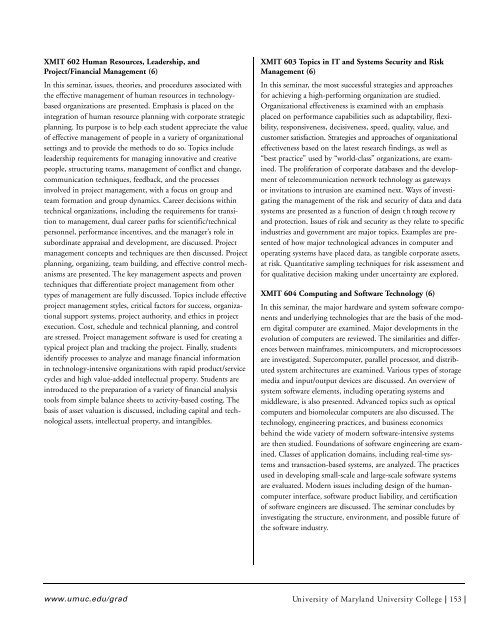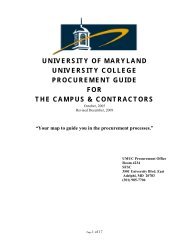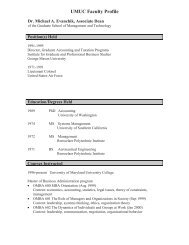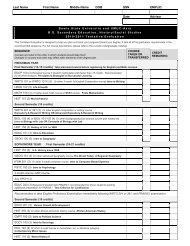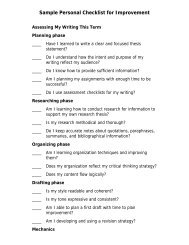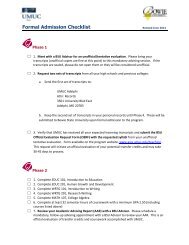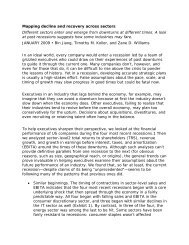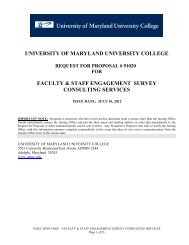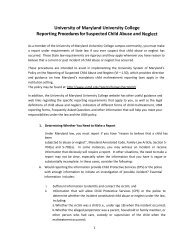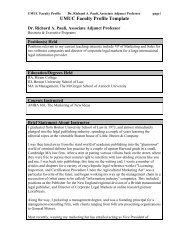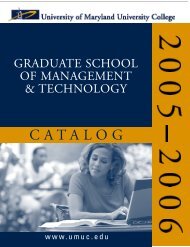A+B. Intro_SJ.1 - University of Maryland University College
A+B. Intro_SJ.1 - University of Maryland University College
A+B. Intro_SJ.1 - University of Maryland University College
You also want an ePaper? Increase the reach of your titles
YUMPU automatically turns print PDFs into web optimized ePapers that Google loves.
XMIT 602 Human Resources, Leadership, and<br />
Project/Financial Management (6)<br />
In this seminar, issues, theories, and procedures associated with<br />
the effective management <strong>of</strong> human resources in technologybased<br />
organizations are presented. Emphasis is placed on the<br />
integration <strong>of</strong> human resource planning with corporate strategic<br />
planning. Its purpose is to help each student appreciate the value<br />
<strong>of</strong> effective management <strong>of</strong> people in a variety <strong>of</strong> organizational<br />
settings and to provide the methods to do so. Topics include<br />
leadership requirements for managing innovative and creative<br />
people, structuring teams, management <strong>of</strong> conflict and change,<br />
communication techniques, feedback, and the processes<br />
involved in project management, with a focus on group and<br />
team formation and group dynamics. Career decisions within<br />
technical organizations, including the requirements for transition<br />
to management, dual career paths for scientific/technical<br />
personnel, performance incentives, and the manager’s role in<br />
subordinate appraisal and development, are discussed. Project<br />
management concepts and techniques are then discussed. Project<br />
planning, organizing, team building, and effective control mechanisms<br />
are presented. The key management aspects and proven<br />
techniques that differentiate project management from other<br />
types <strong>of</strong> management are fully discussed. Topics include effective<br />
project management styles, critical factors for success, organizational<br />
support systems, project authority, and ethics in project<br />
execution. Cost, schedule and technical planning, and control<br />
are stressed. Project management s<strong>of</strong>tware is used for creating a<br />
typical project plan and tracking the project. Finally, students<br />
identify processes to analyze and manage financial information<br />
in technology-intensive organizations with rapid product/service<br />
cycles and high value-added intellectual property. Students are<br />
introduced to the preparation <strong>of</strong> a variety <strong>of</strong> financial analysis<br />
tools from simple balance sheets to activity-based costing. The<br />
basis <strong>of</strong> asset valuation is discussed, including capital and technological<br />
assets, intellectual property, and intangibles.<br />
XMIT 603 Topics in IT and Systems Security and Risk<br />
Management (6)<br />
In this seminar, the most successful strategies and approaches<br />
for achieving a high-performing organization are studied.<br />
Organizational effectiveness is examined with an emphasis<br />
placed on performance capabilities such as adaptability, flexibility,<br />
responsiveness, decisiveness, speed, quality, value, and<br />
customer satisfaction. Strategies and approaches <strong>of</strong> organizational<br />
effectiveness based on the latest research findings, as well as<br />
“best practice” used by “world-class” organizations, are examined.<br />
The proliferation <strong>of</strong> corporate databases and the development<br />
<strong>of</strong> telecommunication network technology as gateways<br />
or invitations to intrusion are examined next. Ways <strong>of</strong> investigating<br />
the management <strong>of</strong> the risk and security <strong>of</strong> data and data<br />
systems are presented as a function <strong>of</strong> design t h rough re c ove ry<br />
and protection. Issues <strong>of</strong> risk and security as they relate to specific<br />
industries and government are major topics. Examples are presented<br />
<strong>of</strong> how major technological advances in computer and<br />
operating systems have placed data, as tangible corporate assets,<br />
at risk. Quantitative sampling techniques for risk assessment and<br />
for qualitative decision making under uncertainty are explored.<br />
XMIT 604 Computing and S<strong>of</strong>tware Technology (6)<br />
In this seminar, the major hardware and system s<strong>of</strong>tware components<br />
and underlying technologies that are the basis <strong>of</strong> the modern<br />
digital computer are examined. Major developments in the<br />
evolution <strong>of</strong> computers are reviewed. The similarities and differences<br />
between mainframes, minicomputers, and microprocessors<br />
are investigated. Supercomputer, parallel processor, and distributed<br />
system architectures are examined. Various types <strong>of</strong> storage<br />
media and input/output devices are discussed. An overview <strong>of</strong><br />
system s<strong>of</strong>tware elements, including operating systems and<br />
middleware, is also presented. Advanced topics such as optical<br />
computers and biomolecular computers are also discussed. T h e<br />
technology, engineering practices, and business economics<br />
behind the wide variety <strong>of</strong> modern s<strong>of</strong>tware-intensive systems<br />
are then studied. Foundations <strong>of</strong> s<strong>of</strong>tware engineering are examined.<br />
Classes <strong>of</strong> application domains, including real-time systems<br />
and transaction-based systems, are analyzed. The practices<br />
used in developing small-scale and large-scale s<strong>of</strong>tware systems<br />
are evaluated. Modern issues including design <strong>of</strong> the humancomputer<br />
interface, s<strong>of</strong>tware product liability, and certification<br />
<strong>of</strong> s<strong>of</strong>tware engineers are discussed. The seminar concludes by<br />
investigating the structure, environment, and possible future <strong>of</strong><br />
the s<strong>of</strong>tware industry.<br />
w w w. u m u c . e d u / g r a d<br />
Un i versity <strong>of</strong> Ma r yland Un i versity <strong>College</strong> | 153 |


